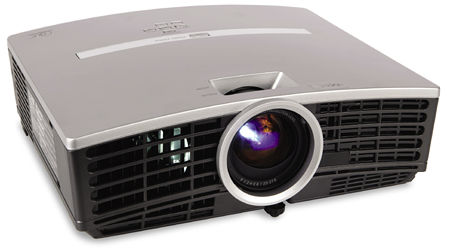Mitsubishi PD-5050 Plasma Monitor

The PD-5050 doesn't break new ground, but it does deliver nice pictures in a very attractive form factor at a competitive price for 50-inch plasmas. This is a bare-bones monitor—there's no digital TV tuner, CableCARD slot, or RF inputs. What you do get is the plasma display, an internal 9-watts-per-channel stereo amplifier, and a full complement of input connectors.
Out of the Box
The PD-5050 can be wall-mounted or attached to the companion MB-5030 tabletop stand, which is how I tested the review unit. This low-profile stand assembles in minutes and is dirt-simple to attach. With stand, the PD-5050 weighs a shade over 100 pounds, which means you can set it up just about anyplace you want.
The supplied remote control is the now-famous NEC "baton" design, which I've always been partial to. It's not that compact, but has an intelligent button layout that you can use with your hand behind your back. Two separate buttons provide power control, and a large rocker switch serves as the volume control. A mousedisk provides menu navigation, and you can access any of seven inputs directly.
Unlike most other plasma monitors and TVs, the connector jackpack is situated on the right side panel—not necessarily the best place if you want to disguise wiring, but a godsend when you need to connect and disconnect components. In addition to both BNC and RCA composite-video jacks and an S-video input, three RCA jacks are provided for connection to a YPbPr analog component video source. This can be anything from a 480i/480p DVD player to 720p and 1080i HD set-top boxes.
For those of us "old fogies," Mitsubishi has also provided a set of five BNC inputs that serves double duty—it can accept either component YPbPr or RGBHV signals from a PC or video scaler. There's a 15-pin D-sub input as well, and it can be hooked up to your set-top box, scaler, or computer. The connector complement is rounded out with an HDMI jack for compatible set-top boxes and DVD players.
Mitsubishi includes three pairs of stereo RCA audio jacks if you wish to use the internal amplifiers (you probably won't). For systems integrators, a standard RS-232C 9-pin jack labeled Monitorlink is provided for connection to a home-automation or room-control system.
 Operation and Menus
Operation and Menus
Mitsubishi hasn't changed its menu interface and onscreen display (OSD) much over the years, just the navigation. In addition to the normal image adjustments, there are also controls for setting of gamma (four steps), RGB gain and bias (for color temperature calibration), and noise reduction (three steps). Your settings can be saved into one of six picture memories.
Mitsubishi also provides five different factory-preset picture modes (Normal, Theater 1, Theater 2, Default, Bright) and four color-temperature settings. For video signals, you can define the setup (black) level to be 0, 3.75IRE, or 7.5IRE, which is a feature I haven't seen before in their products. The HDMI input has a setting for high or low black level as well as brightness and contrast controls.
As mentioned earlier, the BNC jackfield can be set to accept component video or RGB signals. In RGB mode, there are seven different picture presets including Still, Motion, Wide1/2/3, DTV, and Auto. Five different aspect ratios are on tap for everything from HDTV to subtitles and anamorphic DVDs. Additional menu settings let you fine-tune horizontal and vertical image position and size for all images.
Mitsubishi has provided some internal protections against image burn-in. There's a low-power mode, a peak-brightness setting (100%, 75%, 50%, and 25%), two picture-orbiter modes, an inverse and all-white screen mode, and four soft-focus modes. You can even reduce the contrast in the onscreen menu, and adjustable gray sidebars are displayed whenever you display 4:3 material to ensure even aging of the phosphors.
Set-Up and Operation
The PD-5050 briefly occupied one of the two "catbird seats" at my 2005 Super Bowl HDTV Party and was one of the crowd favorites. That particular setup featured a 720p/60 signal taken off-air from local Fox affiliate WTXF-DT, and I can tell you that 720p and 50-inch plasma go together like soup and sandwich—no need for much image scaling and no interlacing artifacts to get rid of.
After returning the PD-5050 to my office, I hooked up every available input to a bevy of analog and digital sources, feeding the panel a diet of 480p, 720p, and 1080i video. I didn't spend a lot of time analyzing its 480i performance, nor did I fiddle much with the composite and S-video inputs.













































